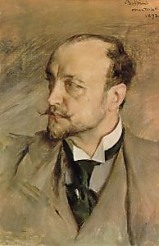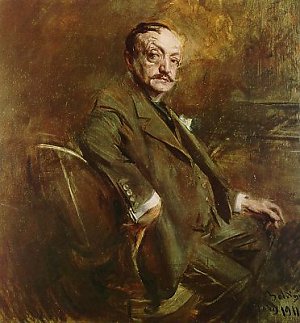
Giovanni
Boldini 1842 - 1931
(Self Portrait, 1892) |
The Dazzling Bravura of
Giovanni Boldini
His exuberant
brush captured extraordinary realism.
 iovanni Boldini (1842-1931) occupies a unique
and glamorous position in the history of portraiture.
Extraordinarily successful as a painter of European
high society, his dazzling bravura style, combined
with brilliant precision, has made him one of
the most admired and studied artists of all
time. In fact, he occupies a position in that
fabled "triumvirate of titans" at
the very pinnacle of portrait painting in the
golden era at the close of the nineteenth century
and the beginning of the twentieth. The names
of John Singer Sargent, Boldini and Sorolla
(the great Spanish master) are invariably linked
when artists discuss this period. While this
remarkable trio shared numerous characteristics,
Boldini's work was distinguished by his slashing,
rapier-like brushstrokes. Boldini was, like
the other two, a consummate draftsman as well
as a master painter of carefully observed tonal
values. But these qualities were often overpowered
by the explosive brush attack.
iovanni Boldini (1842-1931) occupies a unique
and glamorous position in the history of portraiture.
Extraordinarily successful as a painter of European
high society, his dazzling bravura style, combined
with brilliant precision, has made him one of
the most admired and studied artists of all
time. In fact, he occupies a position in that
fabled "triumvirate of titans" at
the very pinnacle of portrait painting in the
golden era at the close of the nineteenth century
and the beginning of the twentieth. The names
of John Singer Sargent, Boldini and Sorolla
(the great Spanish master) are invariably linked
when artists discuss this period. While this
remarkable trio shared numerous characteristics,
Boldini's work was distinguished by his slashing,
rapier-like brushstrokes. Boldini was, like
the other two, a consummate draftsman as well
as a master painter of carefully observed tonal
values. But these qualities were often overpowered
by the explosive brush attack.
 |
1. Self Portrait, 1911
This arresting self portrait showcases
all of the Boldini hallmarks: an
athletic and animated pose is captured
with slashing, even explosive, brushstrokes.
The figure and the chair emerge
from the shifting tonalities of
the background and partake of it.
The exquisitely drawn hands are
each rendered with a few swift strokes.
The head is a marvel of breathtaking
realism, animated, expressive and
alive.
Click here
to see a closeup of the head in
this self portrait.
Oil
on canvas, 41 x 39 inches
(104 x 100 cm).
Museo Boldini, Ferrara
|
|
Sargent and Boldini
became friends in Paris in 1880 (Sargent was
24 and Boldini 38), and remained close throughout
their lives. When Sargent left Paris for London
in 1885, he turned over to Boldini his studio
at 41, Boulevard Berthier. Later, at the encouragement
of Sargent, Boldini made repeated professional
trips to London, often painting clients and
sitters of Sargent.
For years I have
owned a slender volume which I purchased in
Italy, entitled L 'Opera Completa di Boldini
(The Complete Works of Boldini), published by
Rizzoli Editore Milano. In addition to a number
of large color plates, the book features a small
black-and-white thumbnail of every painting
by Boldini. These small monochrome reproductions
have been enormously helpful to me over the
years, suggesting solutions to portrait problems
and inspiring me to "stay loose,"
The Metropolitan
Museum in New York owns a Boldini masterpiece,
his portrait of Consuelo Vanderbilt, the Duchess
of Marlborough, and her son. Inexplicably, this
great painting is never exhibited. The painting
is, however, available for viewing by appointment.
Born in Ferrara,
Italy on 31st December 1842, Giovanni Boldini
received his initial training from his father,
a painter and restorer. A precocious talent,
Boldini attended the Accademia di Belle Arti
(Academy of Fine Arts) in Florence in 1862.
There he met the circle of Tuscan realist painters
known as the Macchiaioli. They were a considerable
influence on Boldini and introduced him to painting
from nature, contemporaneous with the Barbizon
painters of France.
During a visit
to Paris for the Exposition Universelle in 1867,
Boldini was greatly influenced by the paintings
of Courbet, Manet and Degas, artists with whom
he later established lifelong friendships. While
in Paris, Boldini was captivated by what he
considered to be the cultural capital of Europe
and moved there permanently in October 1871,
settling in the Place Pigalle.
During
this period he painted a series of small-scale
works of eighteenth-century and Empire scenes,
commissioned by Adolphe Goupil and other Parisian
dealers, but also concentrated on scenes of
Parisian life and pictures of elegantly dressed
women, many of which were also sold by Goupil.
Boldini
was accepted as one of the foremost portrait
painters of the Belle Epoque in Paris during
the 1890s. His unique style set him apart from
his contemporaries. Though he remained essentially
Paris-based, Boldini occasionally made painting
trips to London.
Boldini
died in Paris on January 12, 1931.
|